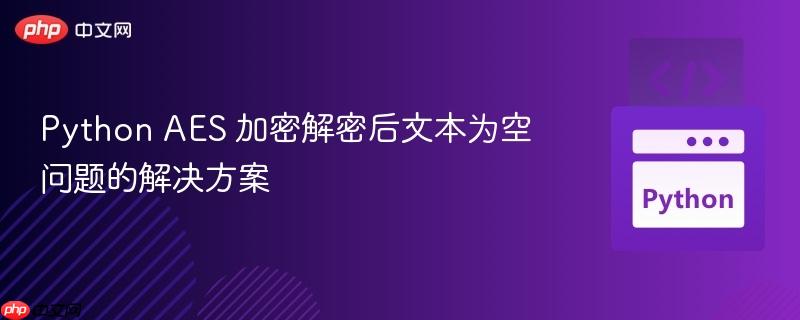
本文旨在解决在使用 Python 的 Crypto 库进行 AES 加密解密时,解密后得到空字符串的问题。通过分析代码,找出问题根源在于密钥处理方式不正确,并提供修正后的代码示例,确保加密和解密过程的正确性,最终实现数据的可靠保护。
在使用 Python 的 Crypto 库进行 AES 加密和解密时,有时可能会遇到解密后文本为空的情况。这通常是由于密钥处理不当造成的。以下将详细介绍如何避免这个问题,并提供正确的代码示例。
问题在于,原始代码中,当提供密钥给 AESCipher 构造函数时,错误地计算了密钥的哈希值,而正确的做法应该是对密钥进行 Base64 解码。AESCipher.get_key 方法将密钥编码为 Base64 字符串,因此在解密时需要进行逆向操作。
正确的 AESCipher 构造函数应如下所示:
立即学习“Python免费学习笔记(深入)”;
import hashlib
from Crypto.Cipher import AES
from Crypto import Random
from base64 import b64encode, b64decode
class AESCipher(object):
def __init__(self, key=None):
# Initialize the AESCipher object with a key,
# defaulting to a randomly generated key
self.block_size = AES.block_size
if key:
self.key = b64decode(key.encode())
else:
self.key = Random.new().read(self.block_size)
def encrypt(self, plain_text):
# Encrypt the provided plaintext using AES in CBC mode
plain_text = self.__pad(plain_text)
iv = Random.new().read(self.block_size)
cipher = AES.new(self.key, AES.MODE_CBC, iv)
encrypted_text = cipher.encrypt(plain_text)
# Combine IV and encrypted text, then base64 encode for safe representation
return b64encode(iv + encrypted_text).decode("utf-8")
def decrypt(self, encrypted_text):
# Decrypt the provided ciphertext using AES in CBC mode
encrypted_text = b64decode(encrypted_text)
iv = encrypted_text[:self.block_size]
cipher = AES.new(self.key, AES.MODE_CBC, iv)
plain_text = cipher.decrypt(encrypted_text[self.block_size:])
return self.__unpad(plain_text)
def get_key(self):
# Get the base64 encoded representation of the key
return b64encode(self.key).decode("utf-8")
def __pad(self, plain_text):
# Add PKCS7 padding to the plaintext
number_of_bytes_to_pad = self.block_size - len(plain_text) % self.block_size
padding_bytes = bytes([number_of_bytes_to_pad] * number_of_bytes_to_pad)
padded_plain_text = plain_text.encode() + padding_bytes
return padded_plain_text
@staticmethod
def __unpad(plain_text):
# Remove PKCS7 padding from the plaintext
last_byte = plain_text[-1]
return plain_text[:-last_byte] if isinstance(last_byte, int) else plain_text关键的修改在于 __init__ 方法中,当 key 参数存在时,使用 b64decode(key.encode()) 对其进行 Base64 解码,而不是计算哈希值。
完整代码示例:
以下是包含修正后的 AESCipher 类的完整代码示例,并包含加密、解密以及保存到文件等功能。
import hashlib
from Crypto.Cipher import AES
from Crypto import Random
from base64 import b64encode, b64decode
class AESCipher(object):
def __init__(self, key=None):
# Initialize the AESCipher object with a key, defaulting to a randomly generated key
self.block_size = AES.block_size
if key:
self.key = b64decode(key.encode())
else:
self.key = Random.new().read(self.block_size)
def encrypt(self, plain_text):
# Encrypt the provided plaintext using AES in CBC mode
plain_text = self.__pad(plain_text)
iv = Random.new().read(self.block_size)
cipher = AES.new(self.key, AES.MODE_CBC, iv)
encrypted_text = cipher.encrypt(plain_text)
# Combine IV and encrypted text, then base64 encode for safe representation
return b64encode(iv + encrypted_text).decode("utf-8")
def decrypt(self, encrypted_text):
# Decrypt the provided ciphertext using AES in CBC mode
encrypted_text = b64decode(encrypted_text)
iv = encrypted_text[:self.block_size]
cipher = AES.new(self.key, AES.MODE_CBC, iv)
plain_text = cipher.decrypt(encrypted_text[self.block_size:])
return self.__unpad(plain_text)
def get_key(self):
# Get the base64 encoded representation of the key
return b64encode(self.key).decode("utf-8")
def __pad(self, plain_text):
# Add PKCS7 padding to the plaintext
number_of_bytes_to_pad = self.block_size - len(plain_text) % self.block_size
padding_bytes = bytes([number_of_bytes_to_pad] * number_of_bytes_to_pad)
padded_plain_text = plain_text.encode() + padding_bytes
return padded_plain_text
@staticmethod
def __unpad(plain_text):
# Remove PKCS7 padding from the plaintext
last_byte = plain_text[-1]
return plain_text[:-last_byte] if isinstance(last_byte, int) else plain_text
def save_to_notepad(text, key, filename):
# Save encrypted text and key to a file
with open(filename, 'w') as file:
file.write(f"Key: {key}\nEncrypted text: {text}")
print(f"Text and key saved to {filename}")
def encrypt_and_save():
# Take user input, encrypt, and save to a file
user_input = ""
while not user_input:
user_input = input("Enter the plaintext: ")
aes_cipher = AESCipher() # Randomly generated key
encrypted_text = aes_cipher.encrypt(user_input)
key = aes_cipher.get_key()
filename = input("Enter the filename (including .txt extension): ")
save_to_notepad(encrypted_text, key, filename)
def decrypt_from_file():
# Decrypt encrypted text from a file using a key
filename = input("Enter the filename to decrypt (including .txt extension): ")
with open(filename, 'r') as file:
lines = file.readlines()
key = lines[0].split(":")[1].strip()
encrypted_text = lines[1].split(":")[1].strip()
aes_cipher = AESCipher(key)
decrypted_bytes = aes_cipher.decrypt(encrypted_text)
# Decoding only if the decrypted bytes are not empty
decrypted_text = decrypted_bytes.decode("utf-8") if decrypted_bytes else ""
print("Decrypted Text:", decrypted_text)
def encrypt_and_decrypt_in_command_line():
# Encrypt and then decrypt user input in the command line
user_input = ""
while not user_input:
user_input = input("Enter the plaintext: ")
aes_cipher = AESCipher()
encrypted_text = aes_cipher.encrypt(user_input)
key = aes_cipher.get_key()
print("Key:", key)
print("Encrypted Text:", encrypted_text)
decrypted_bytes = aes_cipher.decrypt(encrypted_text)
decrypted_text = decrypted_bytes.decode("utf-8") if decrypted_bytes else ""
print("Decrypted Text:", decrypted_text)
# Menu Interface
while True:
print("\nMenu:")
print("1. Encrypt and save to file")
print("2. Decrypt from file")
print("3. Encrypt and decrypt in command line")
print("4. Exit")
choice = input("Enter your choice (1, 2, 3, or 4): ")
if choice == '1':
encrypt_and_save()
elif choice == '2':
decrypt_from_file()
elif choice == '3':
encrypt_and_decrypt_in_command_line()
elif choice == '4':
print("Exiting the program. Goodbye!")
break
else:
print("Invalid choice. Please enter 1, 2, 3, or 4.")注意事项:
总结:
通过修正 AESCipher 类的构造函数,确保在解密时正确处理密钥,可以有效解决 AES 解密后文本为空的问题。同时,注意密钥安全、编码一致性以及正确的填充方式,可以提高加密系统的安全性。
以上就是Python AES 加密解密后文本为空问题的解决方案的详细内容,更多请关注php中文网其它相关文章!

每个人都需要一台速度更快、更稳定的 PC。随着时间的推移,垃圾文件、旧注册表数据和不必要的后台进程会占用资源并降低性能。幸运的是,许多工具可以让 Windows 保持平稳运行。

Copyright 2014-2025 https://www.php.cn/ All Rights Reserved | php.cn | 湘ICP备2023035733号